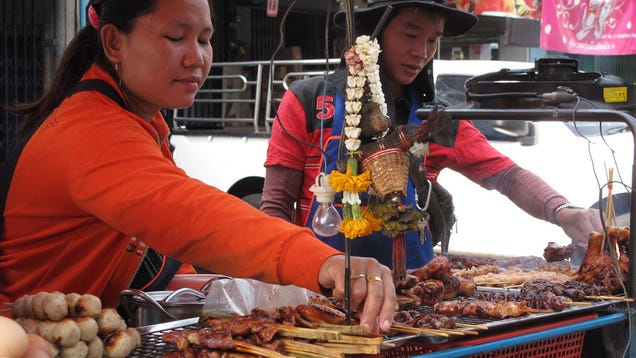Contents contributed and discussions participated by elizmart23
Deep Blue Group of Company Madrid Networks: 10 Tips for Leveraging Packaging-On-Demand ... - 1 views
-
 As small and midsize manufacturers continue to search for cost-effective and efficient transportation and logistics solutions, particularly for managing multi-channel distribution, many are turning to packaging. The latest trend is packaging-on-demand solutions, which enable businesses of any size to create cardboard boxes from bulk corrugated material in a variety of sizes, saving inventory space and packaging and labor costs. Here are 10 tips for using packaging-on-demand solutions efficiently.
As small and midsize manufacturers continue to search for cost-effective and efficient transportation and logistics solutions, particularly for managing multi-channel distribution, many are turning to packaging. The latest trend is packaging-on-demand solutions, which enable businesses of any size to create cardboard boxes from bulk corrugated material in a variety of sizes, saving inventory space and packaging and labor costs. Here are 10 tips for using packaging-on-demand solutions efficiently.
1. Select systems that can accommodate growth plans. Consider planned product volume increases, and choose a system capable of handling those volumes or adapting easily once volume grows.
2. Look for user-friendly packaging systems. Seamless implementation requires that operators fully understand how to run the system effectively. Easy-to-understand user interfaces minimize operating errors, and solutions providers that assist in training operators during installation and startup can reduce the learning curve and help businesses realize faster operational efficiency gains.
3. Determine your current total packaging costs. Review all factors that contribute to your organization's existing packaging costs, then analyze this information to develop a baseline for measuring the return on investment a packaging-on-demand system can deliver for your business.
4. Identify the best materials for protecting your products. Packaging's most important function is protecting the goods being shipped or stored. Test your products' susceptibility to vibration, shock, and surface damage to determine the best-performing material.
5. Determine if centralized or decentralized packaging is best for your business. Shippers moving more than 500 packages per day usually benefit more from centralized packaging - in which each worker is assigned a single packaging task - than lower-volume shippers. Decentralized packaging systems - in which one worker is responsible for a shipment's entire packaging process- offer greater personalization and customization, and are more efficient for companies shipping high-value or fragile products.
6. Review your organization's sustainability objectives. Select packaging that adequately protects products, thus preventing damage and the resulting increase in carbon footprint due to returns and re-shipments. Also consider packaging materials made from renewable or recyclable materials.
7. Examine available physical space. Ensure your facility's existing space will accommodate the packaging-on-demand system for the materials your products require.
8. Decide if you can batch cushioning or void-fill. Can you help manage peak production needs by producing cushioning or void-fill in advance? This will help maintain the production line's flow and avoid packaging bottlenecks when product volume is at its highest.
9. Consider operational efficiency challenges. Is your existing packaging process causing operational bottlenecks? Can space currently devoted to storing or handling pre-fabricated packaging be repurposed to help solve efficiency challenges elsewhere within the operation?
10. Partner with a packaging solutions provider that offers responsive service. The unique operational characteristics of individual facilities or product lines may require fine-tuning packaging-on-demand systems to maximize efficiency, so choose a provider that offers excellent customer service.
Deep Blue Group of Company Madrid Networks: How to Save Money When Traveling to Any Des... - 1 views
-


Spending a lot of money on vacation doesn't mean you will have a better time than someone who spends less. I've been traveling the world for close to a decade on a budget and found that following a few simple tips makes it easy to travel on a budget and still have an amazing trip.
Saving money on the road requires us to break away from a conventional mindset that travel is expensive. This mindset, pushed by a travel industry built on people spending more money, that tells us that we need to stay in hotels, eat at world-class restaurants, or go on packaged tours to have a good time. Of course, that's just not the case, and there are plenty of ways to have a good trip without spending a fortune.
Below are various ways to save in any destination around the world-from cheaper locales like Thailand to more expensive countries like Norway. They will save you big money with minimal effort. I've traveled to over 75 countries in the last eight years. I even wrote a book on budget travel called How to Travel the World on $50 a Day. I know how unbelievable it can sound to say you can travel the world on a budget comfortably, but I know it's possible because I've done it firsthand.
Below are some of the best ways to save money in any destination because when you spend less, you can travel more.
AFFORDABLE ALTERNATIVES TO HOTELS

When you don't need a luxury suite, there are a variety of options for finding housing that won't cost you much. Whether you work in exchange for room and board or simply find a cheap hostel, here are a few alternatives to hotels.
Use a Hospitality Exchange
The best way to save on accommodation is not paying for it-and a hospitality exchange allows you to do exactly that. You've probably heard of "couch surfing," but there are more options than that. Hospitality exchange services connect travelers with locals offering a free place to stay. Sometimes it's a bed, sometimes it's a couch, and sometimes it's literally just space on the floor. These sites work by having users sign up, create profiles, and connect with each other. The expectation is that one day, those who were hosted will pay it forward and host someone else. You're not required to host anyone in the future, but most people find the experience of being hosted rewarding and do host others. There are four major hospitality exchange organizations:
- Couchsurfing
- Servas
- Hospitality Club
- Global Freeloaders
Do Farm Work in Exchange for Room and Board
World Wide Opportunities on Organic Farms, or WWOOFing, matches people looking for work on farms with farms that need labor. You get free room and board in exchange for work! It's an incredible way to stay in one area for free. You don't need any farm experience either. There is no international WWOOF membership, so you'll have to buy a membership from each individual WWOOFing country's organization. Annual membership usually costs around $30 USD per country. Obviously this solution isn't for everyone and is limited to certain areas, but it can be a good way to gain interesting experience while saving money.
Try House Sitting for Long Term Stays
House sitting is exactly like it sounds-while someone else is on holiday, you watch their house and take care of any pets they have while they are gone. House sitting commitments tend to be long term (i.e. a month or more) and are suited for travelers who want to stay longer in one specific place. The biggest house sitting websites are:
- House Carers
- Mind My House
- The Caretaker Gazette
Stay in Hostels
Perhaps the most common solution for travelers looking to save money, hostels are one of the cheapest forms of paid accommodation in the world. Hostels are places that offer shared (and sometimes private) rooms for travelers looking for a cheap place to stay. These dormitory-style rooms usually have between four and 20 beds. The more beds, the cheaper the room.
Hostel prices are about a third of the cost of a hotel room. A cheap hotel in New York City is $100 USD, while a dorm room is $30. In Thailand, where a hotel is $30 USD or more, you can get a cheap dorm room for $5. In Australia, a dorm room is $25 USD versus $110 for a hotel.
Use Serviced Apartments
One option for group travelers, or even people traveling alone who aren't interested in hostels, is serviced apartments. These are apartments owned, furnished, and taken care of by someone else that you rent like a hotel room. People list an extra room, couch, or property they own and want to make money from. It's like couch-surfing, except you pay for it and get your own space. There are many companies that will help you find these apartments around the world, such as:
- 9flats
- Airbnb
- HomeAway
- Roomorama
- Wimdu
- Housetrip
SAVING MONEY ON FOOD AND DRINK

Food can be one of the most substantial daily expenses on your trip, especially if you only stay in the areas frequented by tourists. Instead, venture out to either do some grocery shopping of your own and cook for yourself, or explore locale establishments that don't necessarily cater to tourists.
Cook Your Own Meals
A week's worth of groceries is cheaper than a week's worth of restaurants. I generally find that I spend about $50-$60 USD per week on groceries, as opposed to $20+ per day at restaurants. That's a reduction of 70% in food expenses. Even if you are going away for just a two-week vacation, consider cooking some of your meals. Food costs add up quickly - a snack here and a dinner there and you'll be wasting a lot of your money on food. The majority of hostels, guesthouses, and shared apartments all have full kitchens where you can cook your meals. (They provide the pots, pans, and utensils too!) Even if you are staying at a hotel without a kitchen, you can still prepare your own food by making sandwiches. I recommend trying to stay in a place with kitchen facilities, however, so you can cook some hot meals and reduce your expenses.
Eat Lunch Specials
In many parts of the world, especially in Europe, you can dine on dinner menus at lunch special prices. This so-called plate of the day is one of the best bargains in the world. For example, while I was in Barcelona, I went to eat at the seafood restaurants near the beach. Dinner was around $50 USD. Coming back the next day for the lunch special, however, allowed me to get the same meal for only $20 USD. Singapore is another great destination for lunch specials. While the city is very expensive by Asian standards-food here can cost as much as it does back home-restaurants here have fixed menus for lunch that cost between $10-$15 USD, as opposed to $25 for dinner. In England, pubs provide set meals for as low as $10 USD.
Carry a Reusable Water Bottle
You need to stay hydrated when traveling and buying water every day gets expensive. Get a metal water bottle or reuse your plastic water bottle a few times to save money. I usually use a plastic water bottle for about four days, or more if I can find a place to clean it. Instead of buying three bottles a day, I usually buy two per week. I may only be saving a small amount of money each time, but over the course of a long trip that can really add up. Moreover, I reduce the amount of plastic I use, which is also good for the environment. It's win-win.
If the tap water in your part of the world is not drinkable, you can use a Steripen to purify your water, save money, and reduce your use of plastic bottles.
Never Eat in a Tourist Area
This tip is simple enough, but one people often forget since it's easier to eat near the attractions. Prices in tourist areas generally tend to be 20-50% higher because tourists usually don't mind spending more money on vacation and tend to be unaware of what local prices actually are.
Walk away, go explore some side streets, and find a place where you don't hear much English. It's more challenging and more work, but the food is a lot better and you'll be paying the local price instead of the tourist price. While in Barcelona, my friends and I wandered away from the touristy La Rambla and found a local tapas restaurant. We filled our stomachs for $12 USD each in what would have cost double that on La Rambla, where a single dish can be $20.
Not comfortable just winging it? To find local favorites, ask hotels or hostels, or look on Yelp, Foursqaure, or Openrice.
TRANSPORTATION AND ENTERTAINMENT

No, you don't really need to hire a private car to get around, and you'll likely miss out on a lot of the local culture if you do. When possible, think like a local and explore the city via public transit-or literally join the locals with ride sharing services-while taking advantage of tourist-focused passes that can offer admission to multiple museums and more.
Take Local Transport
Forget the private coaches, taxis, and tourist buses-do what the locals do and take local buses or trains. It may be easier to get in that tourist bus since companies will pick you up from your hotel or hostel and take care of any logistics for you, but it's more fun and much cheaper to figure out the local transportation system. Even in expensive countries like Norway or Sweden, the city train is never more than $4 USD. It may take some time to figure out the map and where you need to go, but learning your way around is half the fun of traveling.
And even if I don't speak the local language, the signs and timetables at the bus stop usually have a price listed. If the price isn't listed, I've never found a bus driver who doesn't understand, "How much?" or at least the confused look on my face while holding a bill out in front of me!
Get Tourism Cards
I will never figure out why travelers don't use tourism cards more often. Local tourism offices (think London Tourism, Paris Tourism, New York Tourism, etc.) issue cards for many of their attractions, tours, and restaurants. These cards (which you will pay a one-time fee for) give you free entry and substantial discounts on many of the attractions and tours in a city, free local public transportation (a huge plus), and discounts at a few restaurants and shopping malls. The cards are typically valid for 1, 3, 5, or 7 days. The first day begins when you first use your card, whether at a museum or on public transportation.
These cards are great for saving money because you get free transportation around the city and free entry into museums, attractions, and tours. For example, in Oslo, Norway, the VisitOslo card offered by the city tourism board costs $60 USD. However, each museum in the city is between $12-15. I saw nine museums in the city on my last visit. I saved $30 USD with the pass and got free public transportation. When I used the Paris Museum Pass while visiting Paris, I saved $85 USD off the normal price of the museums.
One important thing to remember is that while these cards offer great value, the timed nature of them requires you to hustle to get as much value out of them as you can.
Take Advantage of Free Museum Days
Most museums have special discount times or free nights. Even famous museums like the Louvre and the Guggenheim offer occasional free entrance. If I don't have a tourism card that offers free entrance into the museum I want, I scan its website to find out which days and times the museum offers free entrance. Before you go anywhere, make sure you check websites to find out if the museums you want to see offer free visiting hours.
Ask Hostels for Information
You can use hostels for information even if you aren't staying in them. They deal with budget travelers on a day-to-day basis and know the ins and outs of visiting that city on a budget. Go in and ask them for advice on what to see and do on the cheap. They will always be helpful.
Use Cards without Foreign Transaction Fees
Avoid paying a bank fee ever again by getting a no-fee credit and ATM or credit card. Don't give banks your hard-earned money-save it for your trip. Bank fees can add up, and there's no reason to hand over $3-$5 USD with every purchase or withdrawal you make. In order to avoid fees, get a fee free debit card like Charles Schwab. They never charge an ATM fee, and will reimburse you for any fees other banks charge. Capital One's Venture Card is a simple, no annual fee card that doesn't charge any foreign transaction fees.
Utilize Local Ride-Sharing Services
Trains, planes, buses-these can be expensive. An easier and more interesting way to travel is by getting a ride with a local heading in your direction. All you have to do is share the cost of gas. It's cheaper, you get to meet a local, and you can take detours and pit stops if you want. Some recommended websites include:
- Liftshare (based in the UK)
- Mitfahrgelegenheit (Germany)
- Gumtree (UK/Australia/NZ)
- Kangaride (Canada)
- BlaBlaCar (Europe)
Other Sharing Economy Websites
The sharing economy exploded in 2014 and has given travelers direct access to locals who can act as tour guides, hosts, cooks, and drivers. Take advantage of these services to bypass traditional travel companies and save money. Some companies worth using are:
- Colunching
- Vayable
- Eatwith
- Guided by a Local
These tips are good for any destination in the world. No matter where you go in the world, there are always ways to save. The travel media tells us that travel is expensive but years of experience has taught me otherwise. I've written a book called How to Travel the World on $50 a Day and am currently driving across the country on a book tour because I know the tips above and the tips in my book work. Break out of the hotel/resort mindset, use the tips above, and save big.
UK construction industry warned of 'time bomb' from health and safety cuts of Deep Blue... - 4 views
-


The construction industry is sitting on a "ticking time bomb", with inexperienced workers being recruited to work on London's major building sites at a time when safety standards are being run down, according to a former government adviser on the sector.
Baroness Donaghy, who wrote a landmark report, One Death Too Many, for the last Labour government, said there is a severe risk of a rise in deaths and serious injuries as building activity picks up during the recovery. Since 2001, 760 workers have died in industrial accidents on UK building sites.
The number of site-related deaths in London, where growth in construction is strongest, has doubled recently.
Donaghy said she was appalled by a 35% cut in the budget of the Health and Safety Executive (HSE) in 2011, after she had called in her March 2010 report for more funding to allow it to function properly as a regulator. The report was widely accepted by the Labour government, but has since been ignored by the coalition.
Donaghy predicted that companies would cut corners and that accident and deaths would increase. "If there is an upturn, as is obviously happening in London, there is a danger that skills have been lost during the recession, and people who are insufficiently skilled will be taken on. And that's when the deaths and accidents will start taking place."
She added: "I do believe that if the recession is ending, the number of accidents will increase. Is it a ticking time bomb? Possibly right, yes. There is a real danger, without a well-resourced HSE, that corners will be cut."
Only 10% of construction workers are trade union members and the industry has taken on increasing numbers of casual workers over the past two decades.
A freedom of information request from the construction workers' union, Ucatt, showed a 7% fall in unannounced inspections of construction sites between 2011-12 and 2012-13, though the HSE said the number of inspections had risen in 2013-14 to make up for that dip.
The FoI request also revealed a fall in improvement notices - which are HSE-issued orders to employers to address safety risks - from 1,021 in 2011-12 to just 800 the following year. And the number of employers being prosecuted for safety offences also fell, from 456 to 410.
Steve Murphy, the general secretary of Ucatt, said: "I sincerely believe the construction industry is chaotic. And deaths on sites will tragically rise in the next year."
However Heather Bryant, chief inspector for construction at the HSE, said the organisation was adequately resourced, and that construction was one of its priority areas.

To address such risks, experts say shippers should seek as much transparency as possible and pay closer attention to their cargo arrangements than outsourcing has left them in the habit of paying.
"They tend in many cases to give it to third party logistics providers and say, 'let me know when it shows up," said Captain Andrew Kinsey, senior marine risk consultant at Allianz. "They don't understand who's carrying it, how many times it's being moved, transshipped, put into feeder vessels or on barges, etc."
Wm. Morrison Supermarkets MRW.LN +0.27% PLC in the U.K. addresses this through using one main shipping company and embedding a person from that company in its offices. said Martyn Jones, group corporate services director at the company. "We have absolute transparency around where containers are once they leave the factory, all the way through to portside, onto a vessel and then across the water," he said.
The cost of not understanding the chain of custody on cargo can potentially amount to as much as 10 times the direct value of lost merchandise, once business interruption and other costs are factored in, said Linda Conrad, director of strategic business risk, Zurich Global, Corporate in North America. She noted that marine insurance usually doesn't cover the cost of shipment delays, and companies are more vulnerable in the context of just-in-time inventory management, especially when the procurement and risk management functions don't coordinate. "If you are running just in time, what happens just in case?" she asked.
Companies' own cost-cutting efforts aren't the only source of exposure. Shipping lines, hard-hit by the recession, have been taking steps to achieve greater efficiencies through economies of scale and fuel conservation, but these measures can also expose cargo to higher risks.